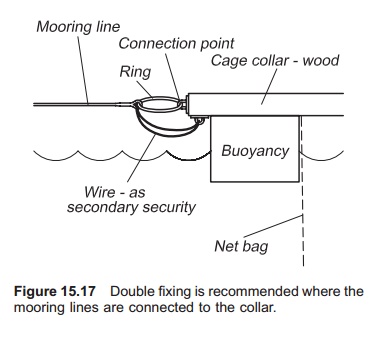Chapter: Aquaculture Engineering : Sea Cages
Mooring lines - Mooring systems
Mooring lines
Different materials and designs can be used for the mooring lines which are often made of synthetic rope. When choosing rope, the breaking strength is the most important factor, but price and duration are also major determinants. The elasticity, given by the E modulus, must also be taken into account. How much a line stretches lengthwise when loaded can be given in the mooring line characteristics.
Lines of synthetic rope are often stretched permanently after the first load so are beyond their elastic range and do not return to their original length. It may be advantageous to pre-stretch the rope before it is used; alternatively, the rope must be tightened after exposure to the environmental loads.

Different materials are used for synthetic ropes, such as PA (nylon), PE, PES and PP, all of which have advantages and disadvantages. PA tolerates the highest forces with a given diameter, while PP ropes have the lowest weight. Metal or Kevlar threads may also be integrated into the rope to increase its strength, but this also increases the cost.
Ropes may be exposed to chafing and this must be avoided. The rope may be covered, for instance with a PE pipe, to reduce chafing. Variable loads, such as occur in mooring lines, will decrease the strength of the rope more than constant loads. The lifetime of synthetic rope in a mooring system can be set as 4 years as a starting point, but will of course depend on the rope and the loads on it.
If a chain is used in the mooring system, it will be exposed to corrosion. Good quality therefore confers an advantage, but this will be a question of price compared to duration. Chain is heavier to handle than rope and therefore more handling time is necessary. Chain tolerates more mechanical influence (chafing) than rope. For this reason chain is often used near the bottom, close to the anchor, normally for the first 15–20 m of the mooring lines. Afterwards rope is used because it is so much easier to handle. To avoid the connection point being exposed to chafing against the bottom, a small buoy may be added here.
Wire or metal rope, may also be used for mooring, but even though it is strong, it is expensive and difficult to work with, so it is seldom used. It may, however, be a good alternative secondary fixing for cages.
Related Topics